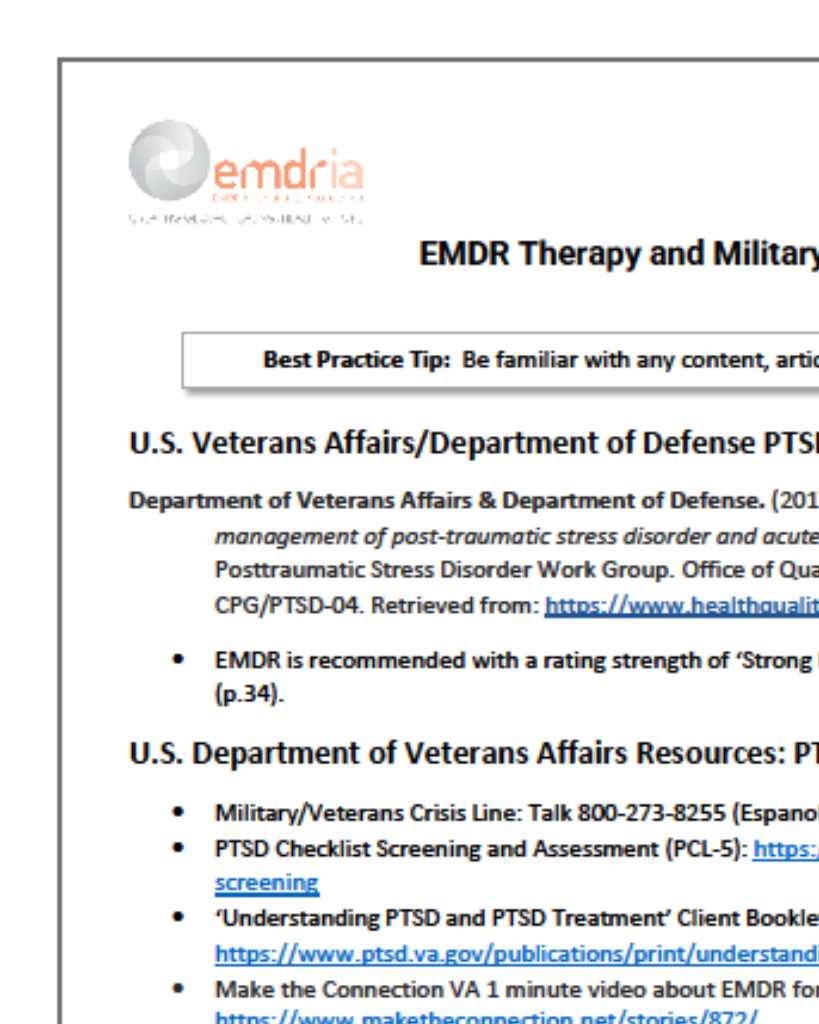EMDR for children with medically related subthreshold PTSD: short-term effects on PTSD, blood-injection-injury phobia, depression and sleep
Investigating short-term effectiveness of EMDR on posttraumatic stress, anxiety, depression & sleep problems in children.
Article Abstract
“Background: Paediatric illness, injury and medical procedures are potentially traumatic experiences with a range of possible negative psychosocial consequences. To prevent psychosocial impairment and improve medical adherence, evidence-based psychotherapy should be offered if indicated. Eye movement desensitization and reprocessing (EMDR) has been found to reduce symptoms of posttraumatic stress disorder (PTSD) in adults. The evidence for the use with children is promising. Furthermore, recent studies indicate its effectiveness for the treatment of other psychological symptomatology. However, the effectiveness of EMDR in children with subthreshold PTSD after medically related trauma has not yet been investigated.
Objective: Investigating the short-term effectiveness of EMDR on posttraumatic stress, anxiety, depression and sleep problems in children with subthreshold PTSD after hospitalization through a randomized controlled trial (RCT).
Method: Following baseline screening of 420 children from various Dutch hospitals, 74 children (4–15 years old) with medically related subthreshold PTSD were randomized to EMDR (n = 37) or care-as-usual (CAU; n = 37). Follow-up assessment took place after M = 9.7 weeks. Generalized Estimating Equation (GEE) analyses were performed to examine the effectiveness of EMDR compared to CAU.
Results: Children in both groups improved significantly over time on all outcomes. However, the EMDR group improved significantly more as to child-reported symptoms of blood-injection-injury (BII) phobia and depression, and child-, and parent-reported sleep problems of the child. There was no superior effect of EMDR compared to CAU on subthreshold PTSD symptom reduction.
Conclusions: EMDR did not perform better than CAU in reducing PTSD symptoms in a paediatric sample of children with subthreshold PTSD after hospitalization. However, the study results indicate that EMDR might be superior in reducing symptoms of blood-injection-injury phobia, depression and sleep problems.”
—Description from publisher
Article Access
Open Access
Meentken, M. G., van der Mheen, M., van Beynum, I. M., Aendekerk, E. W. C., Legerstee, J. S., van der Ende, J., Moll, H. A., Helbing, W. A., & Utens, E. M. W. J. (2020). EMDR for children with medically related subthreshold PTSD: short-term effects on PTSD, blood-injection-injury phobia, depression and sleep. European Journal of Psychotraumatology, 11(1), 1705598. https://doi.org/10.1080/20008198.2019.1705598
Date
January 10, 2020
Creator(s)
Maya G. Meentken, Malindi van der Mheen, Ingrid M. van Beynum
Contributor(s)
Elisabeth W. C. Aendekerk, Jeroen S. Legerstee, Jan van der Ende, Riwka Del Canho, Ramón J. L. Lindauer, Manon H. J. Hillegers, Henriette A. Moll, Wim A. Helbing, Elisabeth M. W. J. Utens
Topics
Anxiety/Panic/Phobias, Depression, Medical/Somatic, Sleep
Client Population
Children
Extent
12 pages
Rights
© 2020 The Author(s). Published by Informa UK Limited, trading as Taylor & Francis Group. This is an Open Access article distributed under the terms of the Creative Commons Attribution-NonCommercial License (http://creativecommons.org/licenses/by-nc/4.0/), which permits unrestricted non-commercial use, distribution, and reproduction in any medium, provided the original work is properly cited.
APA Citation
Meentken, M. G., van der Mheen, M., van Beynum, I. M., Aendekerk, E. W. C., Legerstee, J. S., van der Ende, J., Moll, H. A., Helbing, W. A., & Utens, E. M. W. J. (2020). EMDR for children with medically related subthreshold PTSD: short-term effects on PTSD, blood-injection-injury phobia, depression and sleep. European Journal of Psychotraumatology, 11(1), 1705598. https://doi.org/10.1080/20008198.2019.1705598
Audience
EMDR Therapists, Other Mental Health Professionals
Language
English
Content Type
Article, Peer-Reviewed
Access Type
External Resource, Open Access




